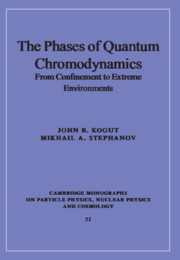Book contents
- Frontmatter
- Contents
- 1 Introduction
- 2 Background in spin systems and critical phenomena
- 3 Gauge fields on a four-dimensional euclidean lattice
- 4 Fermions and nonperturbative dynamics in QCD
- 5 Lattice fermions and chiral symmetry
- 6 The Hamiltonian version of lattice-gauge theory
- 7 Phase transitions in lattice-gauge theory at high temperatures
- 8 Physics of QCD at high temperatures and chemical potentials
- 9 Large chemical potentials and color superconductivity
- 10 Effective Lagrangians and models of QCD at nonzero chemical potential
- 11 Lattice-gauge theory at nonzero chemical potential
- 12 Epilogue
- References
- Index
6 - The Hamiltonian version of lattice-gauge theory
Published online by Cambridge University Press: 17 August 2009
- Frontmatter
- Contents
- 1 Introduction
- 2 Background in spin systems and critical phenomena
- 3 Gauge fields on a four-dimensional euclidean lattice
- 4 Fermions and nonperturbative dynamics in QCD
- 5 Lattice fermions and chiral symmetry
- 6 The Hamiltonian version of lattice-gauge theory
- 7 Phase transitions in lattice-gauge theory at high temperatures
- 8 Physics of QCD at high temperatures and chemical potentials
- 9 Large chemical potentials and color superconductivity
- 10 Effective Lagrangians and models of QCD at nonzero chemical potential
- 11 Lattice-gauge theory at nonzero chemical potential
- 12 Epilogue
- References
- Index
Summary
Continuous time and discrete space
Another form of lattice-gauge theory that is very intuitively appealing is the theory's Hamiltonian form. In many problems it is very instructive to make energyestimates, look at wavefunctions, and estimate the masses, sizes, and shapes of bound states etc. that a quantum-mechanical formulation with a Hamiltonian gives. Sometimes these simple things are hard to extract from a path-integral formulation. Mechanisms of confinement, flux-tube dynamics, and chiral-symmetry breaking are also amenable to Hamiltonian analysis. Decon-finement at finite T and transitions as functions of chemical potential will also be discussed in this formulation below. Since there is much more pioneering physics to be done in QCD in extreme environments, it is important to have many approaches available.
In the Hamiltonian formulation one uses a spatial lattice and leaves the time variable continuous, as we have illustrated in several 1 + 1 examples above. The Hamiltonian is the generator of time evolution and acts on quantized states. The Hamiltonian could be obtained methodically from the path-integral formulation by calculating the system's transfer matrix and then taking the time continuum limit [9]. It is more instructive, however, to construct the Hamiltonian from scratch. In fact, we can think about just two spatial points, write the Hamiltonian for that system, and then consider a full three-dimensional spatial lattice.
As in the Euclidean formulation, the key to the construction is the requirement that local color-gauge invariance be an exact symmetry for any lattice spacing a. Let there be two sites with the link between them.
- Type
- Chapter
- Information
- The Phases of Quantum ChromodynamicsFrom Confinement to Extreme Environments, pp. 136 - 157Publisher: Cambridge University PressPrint publication year: 2003



